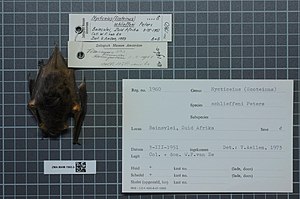Schlieffen bat
| Schlieffen bat | ||||||||||||
|---|---|---|---|---|---|---|---|---|---|---|---|---|

Schlieffen bat ( Nycticeinops schlieffeni ) |
||||||||||||
| Systematics | ||||||||||||
|
||||||||||||
| Scientific name of the genus | ||||||||||||
| Nycticeinops | ||||||||||||
| Hill & Harrison , 1987 | ||||||||||||
| Scientific name of the species | ||||||||||||
| Nycticeinops schlieffeni | ||||||||||||
| ( Peters , 1869) |
The Schlieffen bat ( Nycticeinops schlieffeni ) is a species of bat from the smooth-nosed family , which is native to Africa. The generic name is Greek and means something like "night apparition". The species name honors Count Wilhelm von Schlieffen , who collected the holotype . Like the genus, the species is monotypical .
description
The Schlieffen bat is one of the smallest bats in Africa. The males weigh on average 4.7 g, the females 5.1 g, the forearm is 29–34 mm long in males and 30–33 mm long in females. The coat color varies geographically in different shades of brown, with the hair being one color. The peritoneum is usually a paler brown or whitish. The hair of the peritoneum is two-colored in darker individuals. The Schlieffen bat has a flattened, slightly hairy snout, small, rounded ears and a blunt tragus . The calcar lines over half of the edge of the tail membrane . It differs from Nycticeius humeralis mainly in the shape of the penis bone , but also in the shorter snout.
Way of life
Like most bats, the Schlieffen bat is nocturnal and feeds on insects that it prey on in flight. It hunts mainly in forests and floodplains close to the water , as well as over bodies of water in the dry season. The species is active relatively early in the evening and furrows for about two hours. In Zimbabwe, beetles make up 50% of the diet during the dry season, followed by caddis flies (41%) and moths (6%). In the rainy season, the diet consists of 71% beetles, 19% flies and 5% moths. The Schlieffen bat spends the day in crevices, tree hollows, buildings, cellars and ruins. It is described as solitary, but can also be found in small groups. The reproductive phase of the Schlieffen bat varies geographically. In the subtropical region of Pafuri in the Kruger National Park , mating takes place in June. The females store the sperm in the uterus until ovulation in late August. In November the females give birth to one to three young animals. Bat hairs ( Macheiramphus alcinus ) are well known hunters of the Schlieffen bat.
distribution and habitat
The Schlieffen's bat comes in large parts of Africa south of the Sahara , as well as in Egypt before. The species is classified as harmless by the IUCN thanks to its wide distribution.
literature
- DS Johnston (2006) Nycticeinops schlieffeni . In: Mammalian Species , No. 798, pp. 1-4